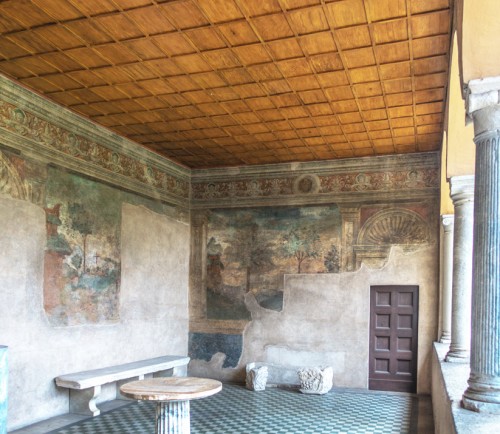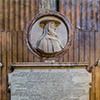
Remains of the epitaph dedicated to Cardinal Bessarion, the courtyard of the Franciscan monastery next to the Basilica of Santi XII Apostoli

Basilica of Santi XII Apostoli, plaque commemorating Cardinal Bessarion

Basilica of Santi XII Apostoli, plaque commemorating Cardinal Bessarion, fragment

Portrait of Cardinal Bessarion, Cristofano dell'Altissimo, pic. Wikipedia

Antoniazzo Romano, frescoes in the Chapel of Cardinal Bessarion, Basilica of Santi XII Apostoli

Cardinal Bessarion's casina in via Porta San Sebastiano

Casina of Cardinal Bessarion, frescoes in the loggia
He first gained renown as the one who converted to Catholicism. He rapidly turned out to be an exceptionally skilled philosopher and interpreter of ancient Greek philosophers, one of those, who after the fall of Constantinople was a proponent of Greek culture in the city on the Tiber. Later he developed diplomatic activities, counting on retaking the city on the Bosporus, but he did not find any supporters. Nobody in Europe had wanted to die for Byzantium, without much grief allowing for the disappearance of a city created in the past by Constantine the Great.
He first gained renown as the one who converted to Catholicism. He rapidly turned out to be an exceptionally skilled philosopher and interpreter of ancient Greek philosophers, one of those, who after the fall of Constantinople was a proponent of Greek culture in the city on the Tiber. Later he developed diplomatic activities, counting on retaking the city on the Bosporus, but he did not find any supporters. Nobody in Europe had wanted to die for Byzantium, without much grief allowing for the disappearance of a city created in the past by Constantine the Great.
Basili (Basileios) Bessarion was born in a family of craftsmen on the shore of the Black Sea, in the area of present-day Turkey. He learned literature and religion in Constantinople where he joined the ranks of the Order of St. Basil. He continued his studies in the Greek city of Mystras, becoming familiar with the philosophy of Plato. It was here, that a philosophical trend was born, which desired to bring back to life the ancient deities in the spirit of Christianity. The intellectual resources combined with the spirit of asceticism allowed Bessarion to gain the title of the metropolitan bishop of Nicaea (a city located near Constantinople). In the face of the threat from the Ottoman Empire towards Byzantium, he concentrated his efforts mostly on attempts to bring together the divided Churches – Eastern and Western. Their union would help or even force the West to aid in the struggle against the Turks. Thanks to his efforts Bessarion became a prominent figure in the Byzantine delegations during the Councils of Ferrara (1438) and Florence (1439), which were aimed at putting an end to the schism which started in 1054 and creating a single doctrine of faith. At first, his stance towards the Roman Church was rather rigid, but in time he began seeing things the pope's way and supported his leading role. He wanted the union to come about at all costs, convincing his own delegation to grant concessions. After the return to Constantinople, the idea of reconciliation was shot down, since the faithful of the Eastern Church, as well as their leaders, were suspicious of the negotiated but highly unsatisfactory stance of the Byzantine delegation. The fact that Bessarion became a Roman cardinal at the behest of Pope Eugene IV, which was supposed to be the beginning of an alliance between the two Churches, only served to add fuel to the fire. Accused of being a Roman sympathizer and the betrayer of his own faith, Bessarion left and settled in the Eternal City. He moved into the Palazzo Colonna, near his titular church, the Santi Apostoli. In his new fatherland, he initially occupied himself with reforming Basilian communities in Southern Italy. He brought back discipline and the spirit of asceticism. Another order that he supported, was the Franciscans who were devoted to him.

His impeccable reputation impressed all Romans, as did his monastic habit which he never removed, and a long beard which he wore as was the tradition in the East. He was a Greek and wanted to emphasize his roots, therefore despite the fact that he continually received Church titles and offices, he remained strict in his life and behavior. The city also gained an outstanding humanist, and an expert in Greek culture, who during the pontificate of subsequent popes, was tasked with the role of animator of intellectual life. He established an informal Academy, which included among others, the librarian Bartolomeo Platina, and which was to house under one roof the works of Greek philosophers, promoting Greek language, but above all “discovering” anew the philosophy of Plato and popularizing his little-known works and thoughts in the West. And it is Bessarion whom we can thank for the view which developed during the Renaissance that rational Christian faith is based on a combination of Plato’s philosophy with the philosophy of Aristotle (see: Raphael’s School of Athens). The cardinal himself wrote several works, in which he spoke out against the Aristotelianism of Saint Thomas Aquinas, however, his main claim to fame was translating Aristotle's Metaphysics into Latin.
When in 1453, news of the fall of Constantinople reached Rome, Bessarion devoted himself to the cause of a crusade with the aim of retaking the city. He gained the support of Pope Pius II and enthusiastically searched for supporters for his idea at the French and Venetian courts. The death of the pope (1464) ultimately brought to an end this project, bringing about the cardinal’s bitterness and disappointment. He devoted the rest of his life to intellectual work. He lived in Palazzo Colonna as well as in a small house located outside the borders of the city (Cardinal Bessarion’s casina) at via di Porta S. Sebastiano, but the city in which he felt at home and with for which he still had high hopes as far as recovering Constantinople, was Venice (known as the second Byzantium). And it was this city, that Bessarion gifted with his great collection of manuscripts and incunabula brought from Constantinople, and in time expanded. In all, he gave the city on the Lagoon, approximately one thousand Greek and Latin works, which were the foundation of an outstanding public library (Biblioteca Marciana). It was the cardinal’s wish that these works would be available to the public.

The idea of an alliance against the Turks was revisited once again during the pontificate of Sixtus IV, however, despite Bessarion's travels and diplomatic talks, he was unable to bring Catholic Europe on board with his ideas. After nearly twenty years of unsuccessful attempts of saving Constantinople, during one such a journey, Bessarion died. He was buried in a chapel gifted to him by the pope in the Church of Santi Apostoli (Cardinal Bessarion’s Chapel), which he had adequately decorated during his life. The chapel was only preserved in fragments, while the epiphany which originated there, is currently embedded into the wall of a cloister garth in the Franciscan convent, located nearby. The earthly remains of the cardinal were transferred to the Chapel of the Holy Sacrament in this very church in 1957.
























